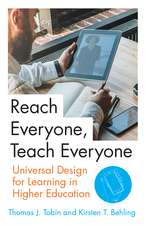Skim, Dive, Surface: Teaching Digital Reading: Teaching and Learning in Higher Education
Autor Jenae Cohnen Limba Engleză Paperback – iun 2021
Smartphones, laptops, tablets: college students are reading on-screen all the time, and digital devices shape students’ understanding of and experiences with reading. In higher education, however, teachers rarely consider how digital reading experiences may have an impact on learning abilities, unless they’re lamenting students’ attention spans or the distractions available to students when they’re learning online.
Skim, Dive, Surfaceoffers a corrective to these conversations—an invitation to focus not on losses to student learning but on the spectrum of affordances available within digital learning environments. It is designed to help college instructors across the curriculum teach digital reading in their classes, whether they teach face-to-face, fully online, or somewhere in between. Placing research from cognitive psychology, neuroscience, learning science, and composition in dialogue with insight from the scholarship of teaching and learning, Jenae Cohn shows how teachers can better frame, scaffold, and implement effective digital reading assignments. She positions digital reading as part of a cluster of literacies that students should develop in order to communicate effectively in a digital environment.
| Toate formatele și edițiile | Preț | Express |
|---|---|---|
| Paperback (1) | 165.42 lei 6-8 săpt. | |
| West Virginia University Press – iun 2021 | 165.42 lei 6-8 săpt. | |
| Hardback (1) | 586.98 lei 6-8 săpt. | |
| West Virginia University Press – 31 mai 2021 | 586.98 lei 6-8 săpt. |
Din seria Teaching and Learning in Higher Education
-
 Preț: 148.68 lei
Preț: 148.68 lei -
 Preț: 105.14 lei
Preț: 105.14 lei -
 Preț: 177.58 lei
Preț: 177.58 lei -
 Preț: 239.99 lei
Preț: 239.99 lei -
 Preț: 231.56 lei
Preț: 231.56 lei -
 Preț: 242.68 lei
Preț: 242.68 lei -
 Preț: 178.17 lei
Preț: 178.17 lei -
 Preț: 188.07 lei
Preț: 188.07 lei -
 Preț: 484.26 lei
Preț: 484.26 lei -
 Preț: 179.52 lei
Preț: 179.52 lei -
 Preț: 215.13 lei
Preț: 215.13 lei -
 Preț: 172.82 lei
Preț: 172.82 lei -
 Preț: 159.05 lei
Preț: 159.05 lei -
 Preț: 159.64 lei
Preț: 159.64 lei -
 Preț: 159.05 lei
Preț: 159.05 lei -
 Preț: 214.56 lei
Preț: 214.56 lei -
 Preț: 215.13 lei
Preț: 215.13 lei -
 Preț: 213.08 lei
Preț: 213.08 lei -
 Preț: 218.42 lei
Preț: 218.42 lei -
 Preț: 232.41 lei
Preț: 232.41 lei
Preț: 165.42 lei
Nou
31.65€ • 32.98$ • 26.21£
Carte tipărită la comandă
Livrare economică 03-17 aprilie
Specificații
ISBN-10: 1952271045
Pagini: 288
Ilustrații: 1 b-w image, 3 tables
Dimensiuni: 127 x 203 x 25 mm
Greutate: 0.42 kg
Ediția:1st Edition
Editura: West Virginia University Press
Colecția West Virginia University Press
Seria Teaching and Learning in Higher Education
Recenzii
Ellen Carillo, author ofMLA Guide to Digital Literacy
Notă biografică
Jenae Cohn writes and speaks about teaching and learning in digital spaces. She works as the director of academic technology at California State University, Sacramento. Find more at www.jenaecohn.net.
Cuprins
Acknowledgments
Introduction: Why Teach Digital Reading?
Part 1. Skim
Understanding Historical, Affective, and Neurological Perspectives on Reading Technologies
1. The Chained Book: A Historical Overview of Reading Technology in Higher Education
2. The Held Book: How Our Feelings for Books Impact How We Teach Reading
3. The Brain on Books: What the Neuroscience of Reading Can Tell Us about Reading on Screens
Part 2. Dive
Exploring the Digital Reading Framework to Promote Deep Reading Practices
An Introduction to the Digital Reading Framework: Curation, Connection, Creativity, Contextualization, Contemplation
4. Curation
5. Connection
6. Creativity
7. Contextualization
8. Contemplation
Part 3. Surface
Critically Approaching the Adoption and Use of Digital Reading Technologies
9. The Ethical Implications of Digital Reading: Grappling with Digital Archiving, Readerly Privacy, and Evidence of Our Reading
Conclusion: Principles, Practices, and Futures for Digital Reading
Appendix: Tools for Digital Reading
References
Index
Textul de pe ultima copertă
Smartphones, laptops, tablets: college students are reading on-screen all the time, and digital devices shape students’ understanding of and experiences with reading. In higher education, however, teachers rarely consider how digital reading experiences may have an impact on learning abilities, unless they’re lamenting students’ attention spans or the distractions available to students when they’re learning online.
Skim, Dive, Surface offers a corrective to these conversations—an invitation to focus not on losses to student learning but on the spectrum of affordances available within digital learning environments. It is designed to help college instructors across the curriculum teach digital reading in their classes, whether they teach face-to-face, fully online, or somewhere in between. Placing research from cognitive psychology, neuroscience, learning science, and composition in dialogue with insight from the scholarship of teaching and learning, Jenae Cohn shows how teachers can better frame, scaffold, and implement effective digital reading assignments. She positions digital reading as part of a cluster of literacies that students should develop in order to communicate effectively in a digital environment.
Descriere
Students are reading on screens more than ever—how can we teach them to be better digital readers?
Smartphones, laptops, tablets: college students are reading on-screen all the time, and digital devices shape students’ understanding of and experiences with reading. In higher education, however, teachers rarely consider how digital reading experiences may have an impact on learning abilities, unless they’re lamenting students’ attention spans or the distractions available to students when they’re learning online.
Skim, Dive, Surface offers a corrective to these conversations—an invitation to focus not on losses to student learning but on the spectrum of affordances available within digital learning environments. It is designed to help college instructors across the curriculum teach digital reading in their classes, whether they teach face-to-face, fully online, or somewhere in between. Placing research from cognitive psychology, neuroscience, learning science, and composition in dialogue with insight from the scholarship of teaching and learning, Jenae Cohn shows how teachers can better frame, scaffold, and implement effective digital reading assignments. She positions digital reading as part of a cluster of literacies that students should develop in order to communicate effectively in a digital environment.










